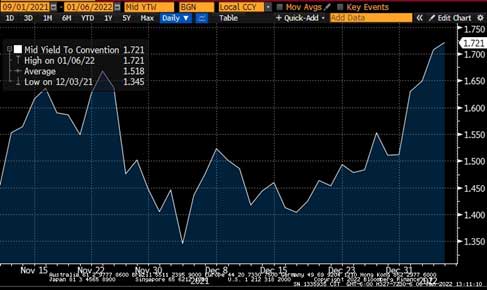After a decade of concern about inflationary pressure that never materialized, it appears inflation may finally have arrived. In the last few months:
- the Consumer Price Index climbed 7.0% in 2021, the highest it has been in nearly 40 years
- the Producer Price Index soared 9.7% in 2021
- the 10-year Treasury rate increased from 1.35% to 1.73% since early December
- the Federal Reserve recently signaled that three rate hikes may be warranted in 2022 due to inflationary concerns
Potential impact on municipalities and non-profit borrowers
This creates concern for municipal and non-profit borrowers for a couple of important reasons.
First, inflation expectations are a key factor in determining the cost of borrowing in the market. As some may recall from Economics 101, the formula for interest rates is:
i = rf + e + cp
In that formula, “rf” is the risk-free rate, “e” is inflation expectations, and “cp” is the credit risk premium for the borrower. So, as inflation expectations rise, interest rates will follow—and that is what we have already seen in the market as shown in the following chart of 10-year Treasury rates.
Source: Bloomberg
As borrowing costs increase, the capacity to issue additional debt decreases with interest making up a larger portion of the debt service which reduces the amount of principal that can be borrowed.
Second, inflation increases the cost of goods and services, including construction costs for capital projects that borrowers may be considering. As the cost of projects increase, the capacity to finance these projects decreases. As a result, borrowers are doubly impacted with rising inflation through higher borrowing costs and higher project costs, both of which reduce their capacity to finance much-needed projects.
Potential action steps
So, what should municipalities and non-profit borrowers consider doing in this environment? There are several things you may want to consider:
- Consider converting any floating rate debt to fixed rate debt. Although many borrowers use their investment portfolio as a natural hedge for floating rate debt, it may still make sense to lock in a low fixed rate now for any variable rate debt you may have.
- Consider advance refunding outstanding tax-exempt or taxable debt that may have a higher interest rate with a taxable or converting rate bond issue (sometimes known as “Cinderella” bonds). With the yield curve flattening, higher short-term rates allow for more efficient escrows which decreases the negative arbitrage from a taxable advance refunding and increases the savings to the borrower.
- Consider moving up the timetable for larger capital projects to take advantage of lower interest rates and lower project costs (interest rates are still relatively low versus historical averages).
- For projects that can’t be accelerated, consider issuing tax-exempt debt to finance capital needs that would typically be funded with cash (up to three years of capital expenditures) and using that cash instead to pay for a larger capital project that may be two or three years down the road.
- Consider alternative call provisions and review of debt policies to maintain flexibility in a potentially rising interest rate environment.
For any of these–and a wide range of other strategies–it’s important to dig into the specifics of an issuer’s current debt structure and future financing needs.
Learn more about how UMB Bank, n.a. Public Finance can support your organization’s financing and capital needs, or contact us to be connected with a public finance specialist.
Disclosure
This communication is provided for informational purposes only and is (1) not an offer or solicitation for the purchase or sale of any financial instrument; (2) not a solicitation to participate in any trading strategy; (3) not an official confirmation of any transaction; and (4) not a recommendation of action to a municipal entity or obligated person and does not otherwise provide municipal advisor advice. The opinions expressed in the communications are those of the author and do not necessarily represent the opinions of UMB Bank, n.a., UMB Financial Services, Inc., or UMB Financial Corporation (Collectively “UMB”). The communication is based upon information available at the time of publication and is believed to be reliable, but UMB does not warrant its completeness or accuracy, and it is subject to change at any time without notice. UMB is not liable for any errors, omissions, or misstatements. You should discuss any information and material contained in this communication with any and all internal or external advisors or other professionals that are deemed appropriate before acting on this information. Please read all offering information, prospectus, or any other required disclosures before initiating any transaction. Past performance is no indication of future results.
UMB Bank, n.a. Capital Markets Division is a separately identifiable division of UMB Bank, n.a. UMB Bank, n.a., is a subsidiary of UMB Financial Corporation. UMB Financial Services, Inc., Member FINRA, SIPC, is a wholly owned subsidiary of UMB Financial Corporation, and an affiliate of UMB Bank, n.a.
| Securities are: NOT FDIC INSURED | NO BANK GUARANTEE | MAY LOSE VALUE |






